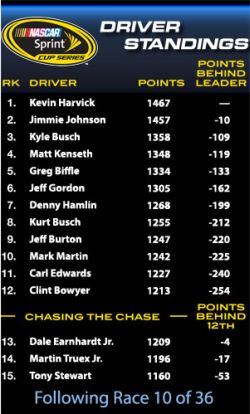Darlington Tough To Tame, Tougher To Win
“The Lady In Black” – aka, Darlington Raceway – may have added a few flourishes to her gown in recent years (new infield tunnel, pavement, grandstands, etc.) – but rest assured she’s the same ornery matron that NASCAR Sprint Cup Series drivers alternately love and loathe.
The egg-shaped track in South Carolina’s sand hills is one of NASCAR’s oldest-sanctioned facilities (Johnny Mantz won its first NASCAR Sprint Cup race in 1950). It’s also the sport’s first superspeedway, and despite her age, Darlington remains a challenge. Drivers who triumph there view those victories as career highlights; whoever captures Saturday night’s SHOWTIME Southern 500 will do the same, whether as a firsttimer or a repeat winner.
“Only the best of the best in our sport go on to win there,” said Jeff Gordon (No. 24 Dupont/National Guard Chevrolet), who leads all active drivers with seven Darlington victories.
Saturday night’s event – a more recent tradition under the lights, on Mother’s Day weekend – marks the third consecutive race at one of NASCAR’s classic tracks. Talladega Superspeedway (the biggest track on the series schedule, at 2.66 miles) was the first three weeks ago, producing series and track records for lead changes and lap leaders along with an eye-blink victory by Kevin Harvick (No. 29 Shell/Pennzoil Chevrolet) over Jamie McMurray (No. 1 McDonald’s Chevrolet).
Last Saturday night, it was .75-mile Richmond International Raceway, another unique venue. Winner Kyle Busch (No. 18 Doublemint Toyota) bested Gordon, the second-place finisher there, after a pair of late-race restarts.
This Saturday, it’s the SHOWTIME Southern 500 at Darlington, of which Gordon, the four-time NASCAR Sprint Cup champion, explains the allure.
“When I came along, the history of the track and how it fit into NASCAR’s history was very well documented,” he said. “The names, (Richard) Petty and (David) Pearson and (Cale) Yarborough and (Dale) Earnhardt, those were things that stuck out to me as, ‘Wow, if you can win here then you’re really doing something.’ ’’
 Step out of line, drivers say, and The Lady will slap you with a “Darlington stripe” – a nasty black streak on the car’s right side, testament to a run-in with a wall. Turns 3 & 4, tight and narrow – the top of the “egg” – are notorious for it. Turns 1 & 2 can deliver no less of a rebuke, though they’re more expansive – the “bottom of the egg.”
Step out of line, drivers say, and The Lady will slap you with a “Darlington stripe” – a nasty black streak on the car’s right side, testament to a run-in with a wall. Turns 3 & 4, tight and narrow – the top of the “egg” – are notorious for it. Turns 1 & 2 can deliver no less of a rebuke, though they’re more expansive – the “bottom of the egg.”
“Three and four have less grip,” said Jeff Burton (No. 31 Caterpillar Chevrolet), a two-time Darlington winner. “One and two are banked more.”
That leads to constant conversation and compromise between driver and crew chief. Set up your car for one pair of turns, and be prepared to sacrifice performance at the track’s other end. “There’s just no room for error,” Burton. “At Darlington, the groove is narrow and the track is narrow.” A fresh coat of asphalt prior to the 2008 race weekend substituted one challenge for another. Before the repaving project, Darlington’s rough, sandy surface chewed tires, making tire management – and the ability to set up the car around tire wear – a crucial strategy. Darlington’s asphalt now is smooth, and very speedy.
Think 170 mph on a two-lane road. Or, as Burton says, “It’s harder in a different way.” “Track position is extremely important,” Gordon said. “You have to compromise as a driver, as a team with the set up because both ends of the race track are totally different so you’re never going to have a perfect car or perfect set up. As a driver, you have to work around that and try to find the fastest way. That place is fast now and it’s hard to pass.”




